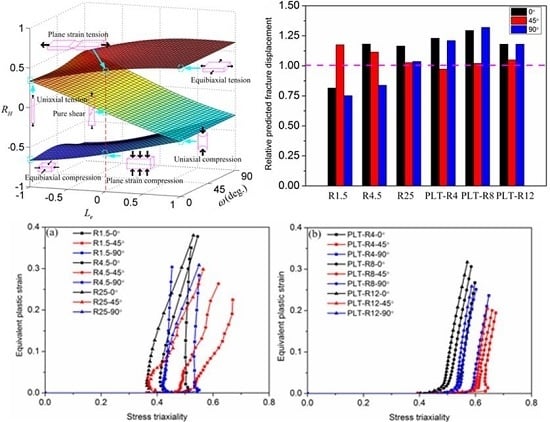A Novel Damage Model to Predict Ductile Fracture Behavior for Anisotropic Sheet Metal
Abstract
1. Introduction
2. Materials and Methods
2.1. Materials and Experiment
2.2. Characterization of the Stress State
2.3. Characterization of the Damage Variable
2.4. Determination of Anisotropy and Damage Parameters
2.5. Numerical Simulation
3. Results
3.1. Calibration of Finite Element Models
3.2. Analysis of Failure Locations
3.3. Evolutions of Equivalent Plastic Strain and Damage
4. Discussion
5. Conclusions
- (1)
- Stress concentration and necking together affect the location of fracture onset for notched specimens. With the increase of stress triaxiality, the fracture location transfers from the center to the root of the notch. In addition, diffuse necking dominates at the 45° direction and localized necking dominates at the 0° and 90° directions.
- (2)
- The predictability of the novel damage model presents good result for five cases (specimens R25 (45°, 90°), PLT-R4 (45°), PLT-R8 (45°), and PLT-R12 (45°)), while the predictive results of other cases show an absolute error of 11.44%~32.26%. The predictive error of notched tension and flat-grooved specimens with 45° is lower than that of two other directions (0° and 90°). The fracture strain of the notched tension specimen is larger than the flat-grooved specimen, and the fracture strain increases with the decrease of the notch and groove radii. In addition, the fracture strain at the 0° direction is highest.
- (3)
- Stress triaxiality plays a very important role in the fracture process, but not a dominant role for notched tension specimens; however, it plays a major role for flat-grooved tension specimens. The effect of plasticity anisotropy is responsible for some differences of stress triaxiality and damage in the center.
- (4)
- Diffuse and localized necking types competitively affect the fracture processes at the 0°, 45°, and 90° directions. Diffuse necking dominates at the 45° direction, while localized necking dominates at the 0° and 90° directions. The effect of the two necking types decreases with the decrease of stress concentration.
Author Contributions
Funding
Acknowledgments
Conflicts of Interest
References
- Fourmeau, M.; Børvik, T.; Benallal, A.; Hopperstad, O.S. Anisotropic failure modes of high-strength aluminium alloy under various stress states. Int. J. Plast. 2013, 48, 34–53. [Google Scholar] [CrossRef]
- Luo, M.; Dunand, M.; Mohr, D. Experiments and modeling of anisotropic aluminum extrusions under multi-axial loading—Part II: Ductile fracture. Int. J. Plast. 2012, 32–33, 36–58. [Google Scholar] [CrossRef]
- Bron, F.; Besson, J. Simulation of the ductile tearing for two grades of 2024 aluminum alloy thin sheets. Eng. Fract. Mech. 2006, 73, 1531–1552. [Google Scholar] [CrossRef]
- Steglich, D.; Brocks, W.; Heerens, J.; Pardoen, T. Anisotropic ductile fracture of Al 2024 alloys. Eng. Fract. Mech. 2008, 75, 3692–3706. [Google Scholar] [CrossRef]
- Benzerga, A.A.; Besson, J.; Pineau, A. Anisotropic ductile fracture: Part II: Theory. Acta Mater. 2004, 52, 4639–4650. [Google Scholar] [CrossRef]
- Chen, Z.; Dong, X. The GTN damage model based on Hill’48 anisotropic yield criterion and its application in sheet metal forming. Comput. Mat. Sci. 2009, 44, 1013–1021. [Google Scholar] [CrossRef]
- Beese, A.M.; Luo, M.; Li, Y.; Bai, Y.; Wierzbicki, T. Partially coupled anisotropic fracture model for aluminum sheets. Eng. Fract. Mech. 2010, 77, 1128–1152. [Google Scholar] [CrossRef]
- Wierzbicki, T.; Xue, L. On the Effect of the Third Invariant of the Stress Deviator on Ductile Fracture; Technical Report No. 136; Impact and Crashworthiness Laboratory: Cambridge, MA, USA, 2005. [Google Scholar]
- Bai, Y.; Wierzbicki, T. Application of extended Mohr-Coulomb criterion to ductile fracture. Int. J. Fract. 2010, 161, 1. [Google Scholar] [CrossRef]
- Jansen, Y.; Logé, R.E.; Milesi, M.; Massoni, E. An anisotropic stress based criterion to predict the formability and the fracture mechanism of textured zinc sheets. J. Mater. Process. Technol. 2013, 213, 851–855. [Google Scholar] [CrossRef]
- Stoughton, T.B.; Yoon, J.W. Modified Mohr-Coulomb fracture model for anisotropic sheet materials under limited triaxial stress conditions. AIP Conf. Proc. 2013, 1567, 562–566. [Google Scholar]
- Park, N.; Huh, H.; Yoon, J.W.; Stoughton, T.B.; Rolfe, B.; Beynon, J.H.; Hodgson, P. Anisotropy effect on the stress-based fracture forming limit diagram using a modified Lou-Huh ductile fracture criterion. AIP Conf. Proc. 2013, 1567, 370–373. [Google Scholar]
- Park, N.; Huh, H.; Lim, S.J.; Lou, Y.; Kang, Y.S.; Seo, M.H. Facture-based forming limit criteria for anisotropic materials in sheet metal forming. Int. J. Plast. 2017, 96, 1–35. [Google Scholar] [CrossRef]
- Lou, Y.; Huh, H. Extension of a shear-controlled ductile fracture model considering the stress triaxiality and the Lode parameter. Int. J. Solids Struct. 2013, 50, 447–455. [Google Scholar] [CrossRef]
- Cao, J.; Li, F.; Ma, X.; Sun, Z. Study of fracture behavior for anisotropic 7050-T7451 high-strength aluminum alloy plate. Int. J. Mech. Sci. 2017, 128–129, 445–458. [Google Scholar] [CrossRef]
- Lemaitre, J.; Dufailly, J. Damage measurements. Eng. Fract. Mech. 1987, 28, 643–661. [Google Scholar] [CrossRef]
- Tasan, C.C.; Hoefnagels, J.P.M.; Geers, M.G.D. Identification of the continuum damage parameter: An experimental challenge in modeling damage evolution. Acta Mater. 2012, 60, 3581–3589. [Google Scholar] [CrossRef]
- Cao, J.; Li, F.; Li, P.; Ma, X.; Li, J. Analysis of ductile–brittle competitive fracture criteria for tension process of 7050 aluminum alloy based on elastic strain energy density. Mater. Sci. Eng. A 2015, 637, 201–214. [Google Scholar] [CrossRef]
- Rice, J.R.; Tracey, D.M. On the ductile enlargement of voids in triaxial stress fields. J. Mech. Phys. Solids 1969, 17, 201–217. [Google Scholar] [CrossRef]
- Panich, S.; Uthaisangsuk, V.; Suranuntchai, S.; Jirathearanat, S. Investigation of anisotropic plastic deformation of advanced high strength steel. Mater. Sci. Eng. A 2014, 592, 207–220. [Google Scholar] [CrossRef]
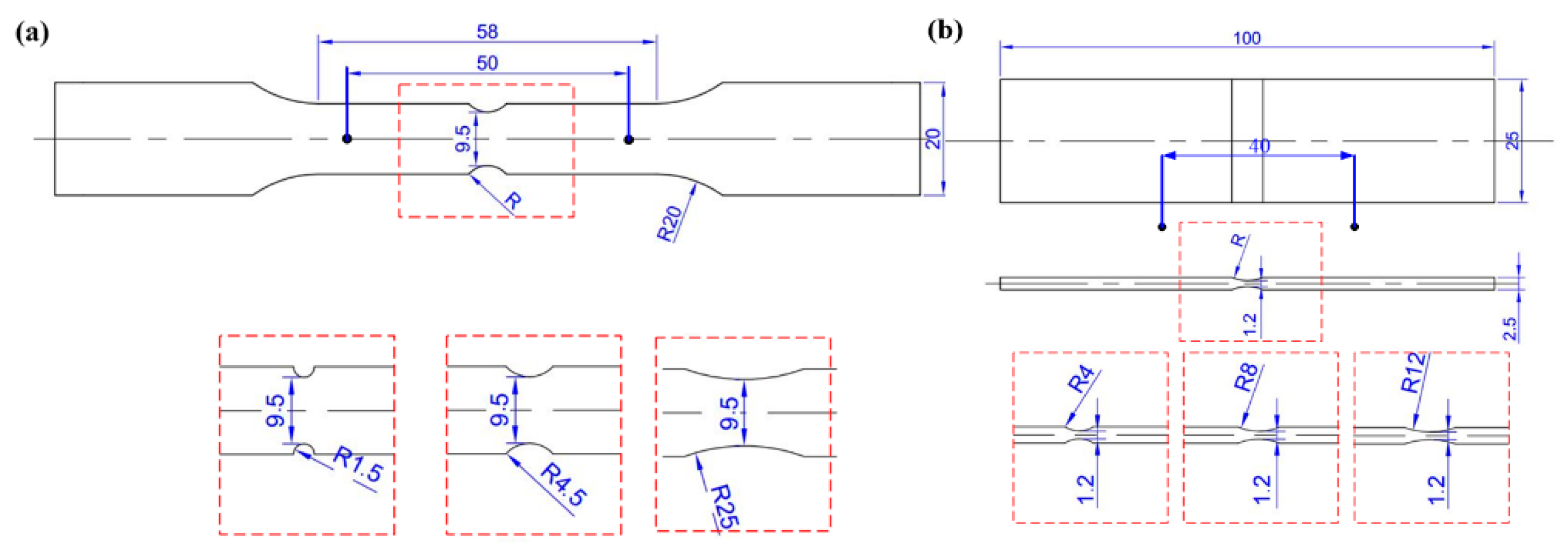

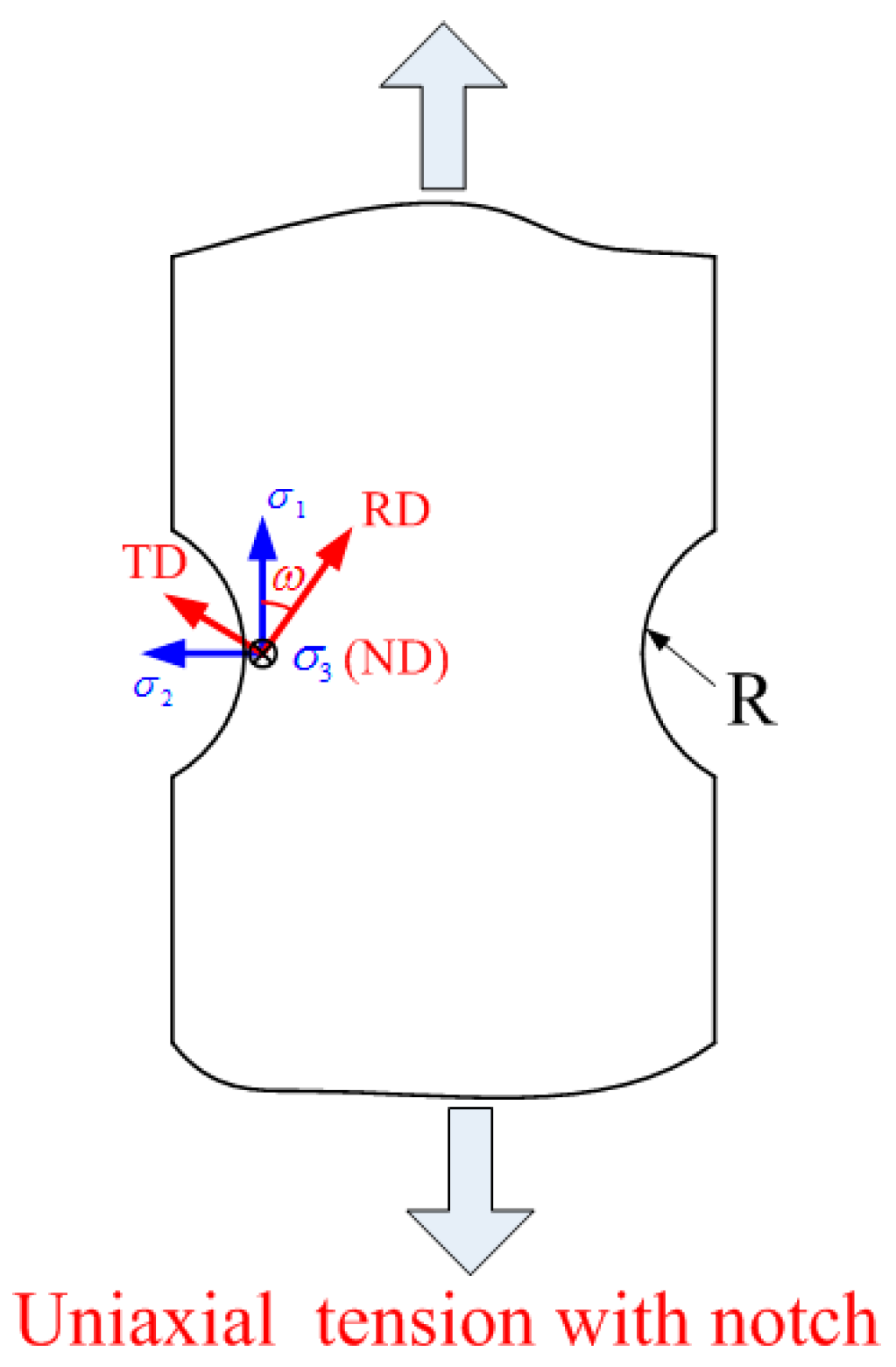

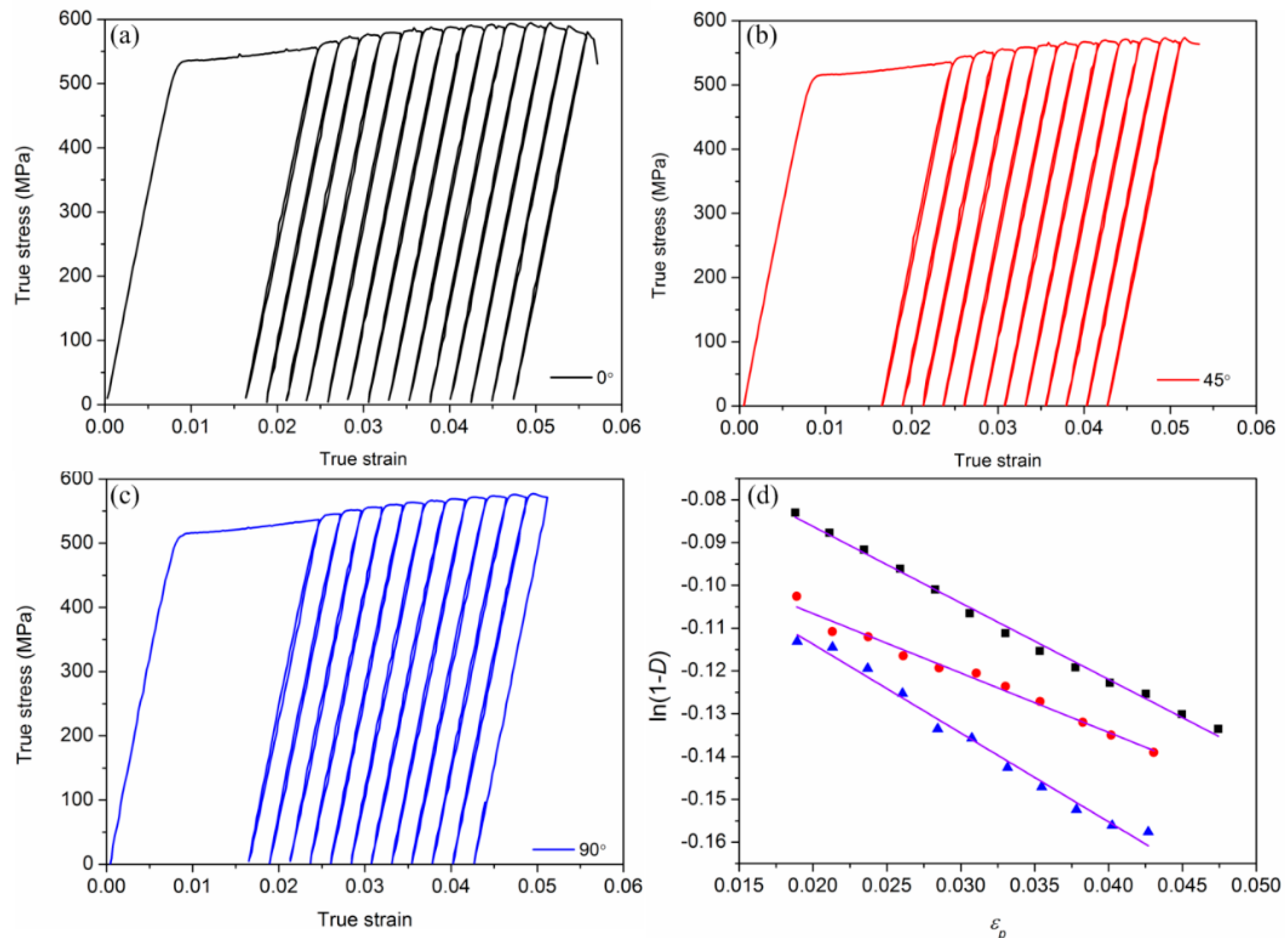
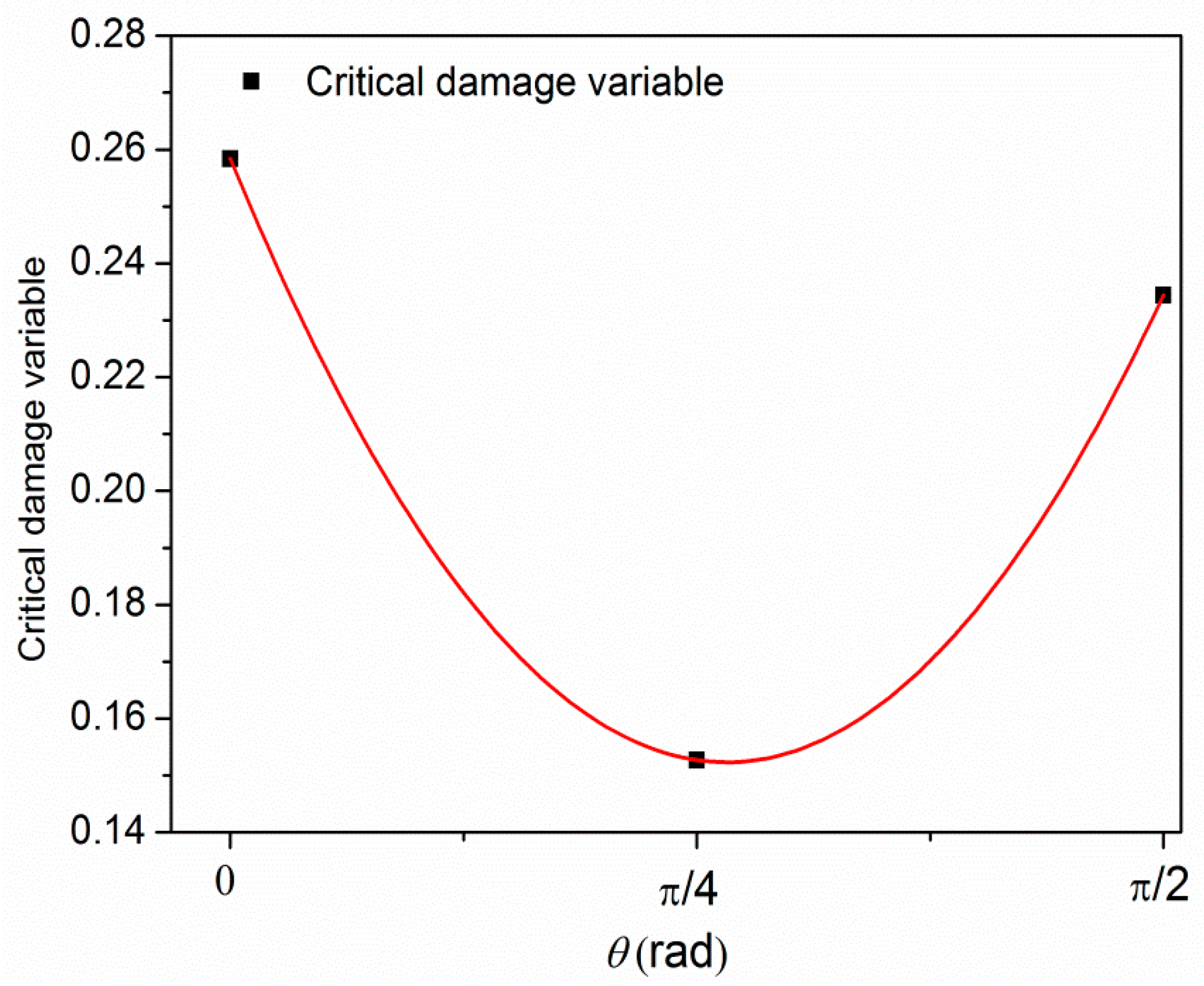


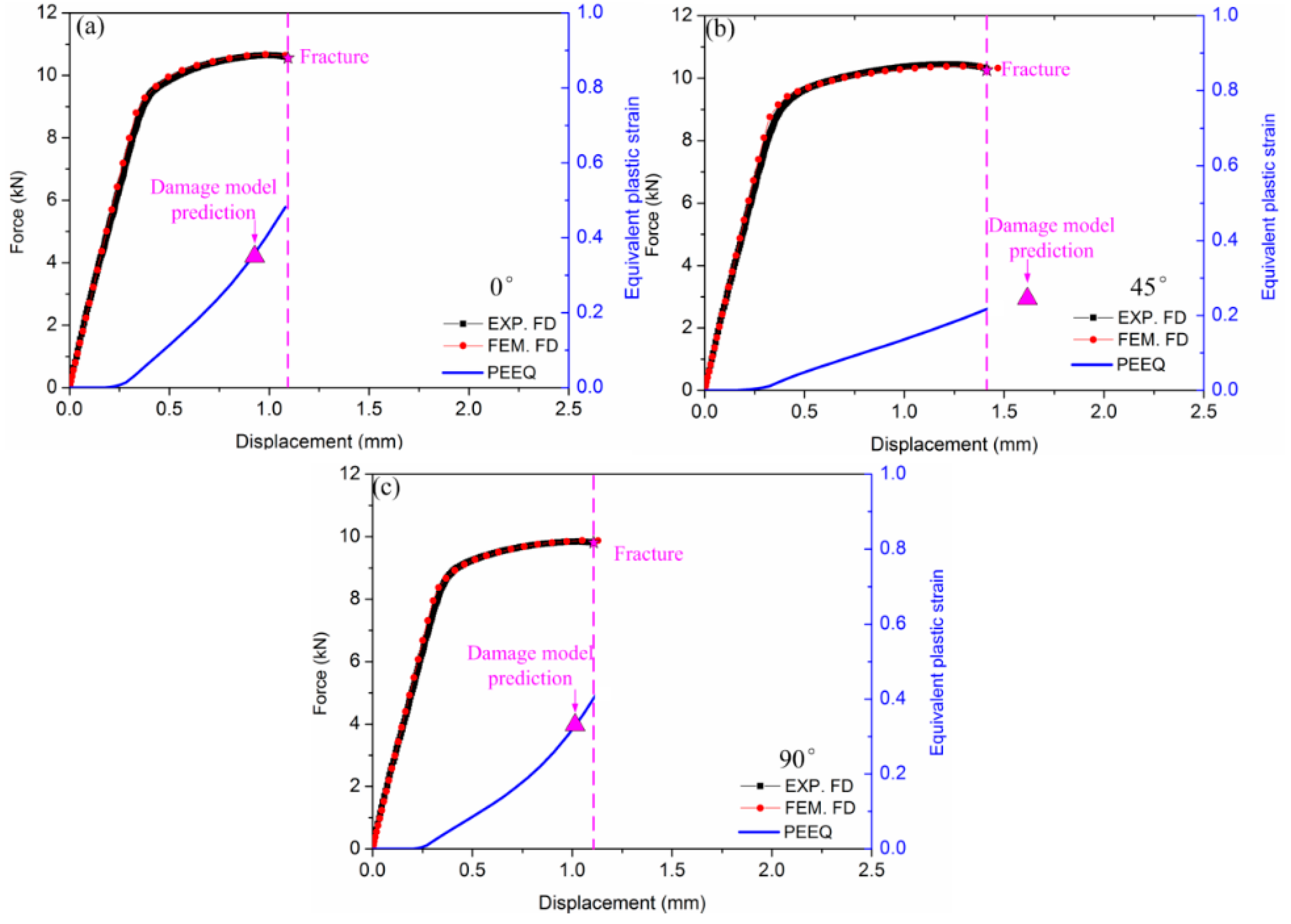


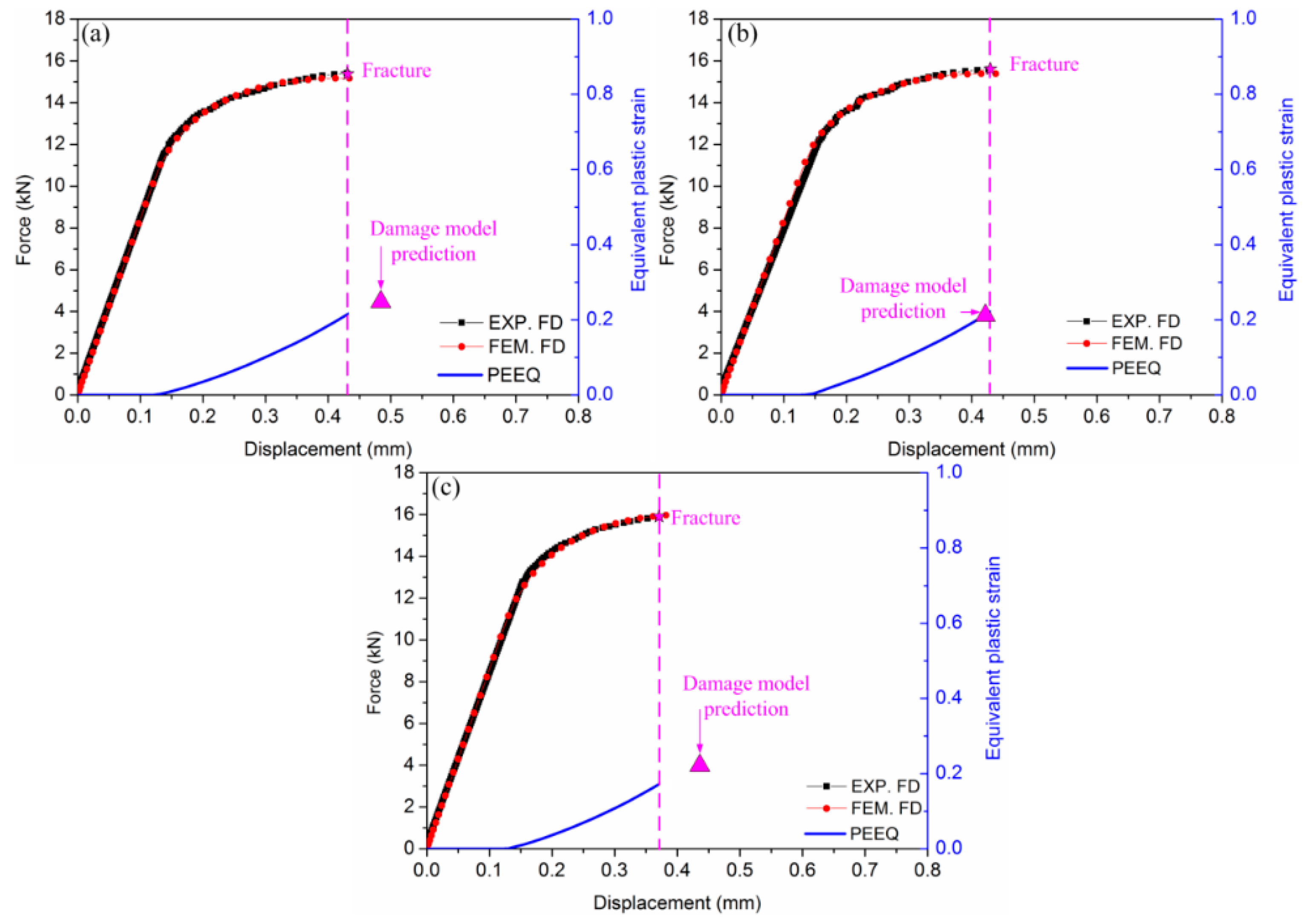


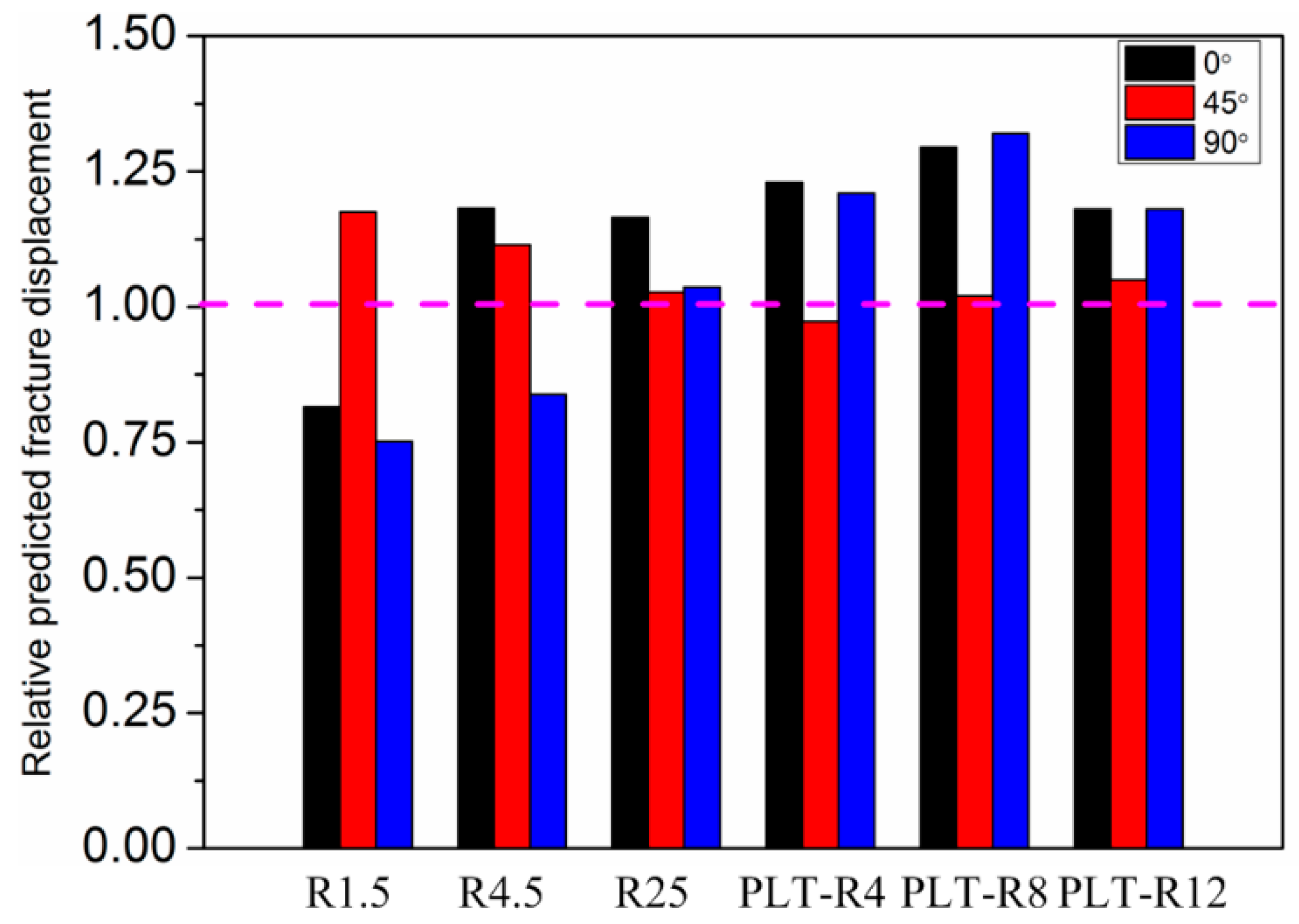
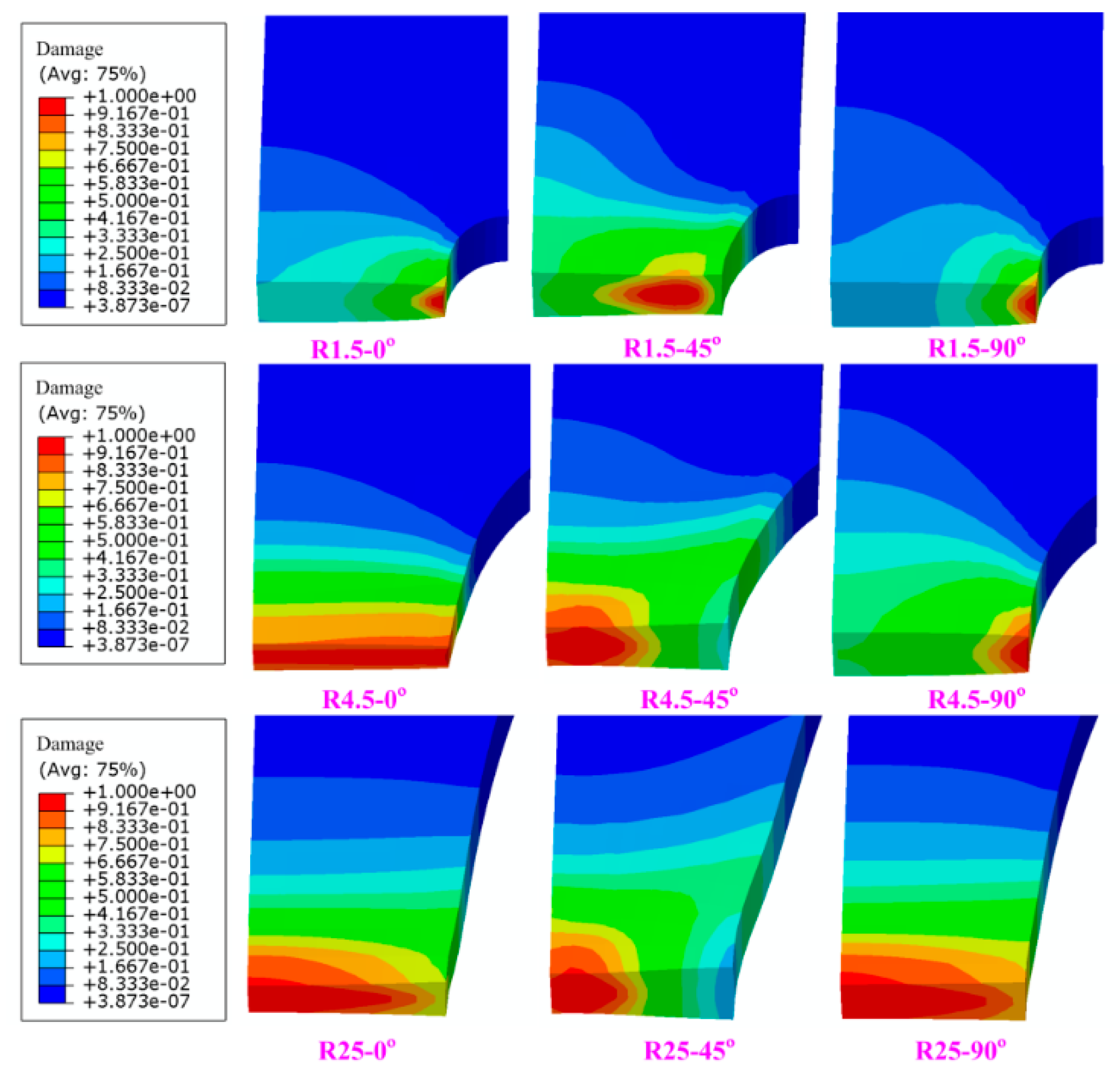

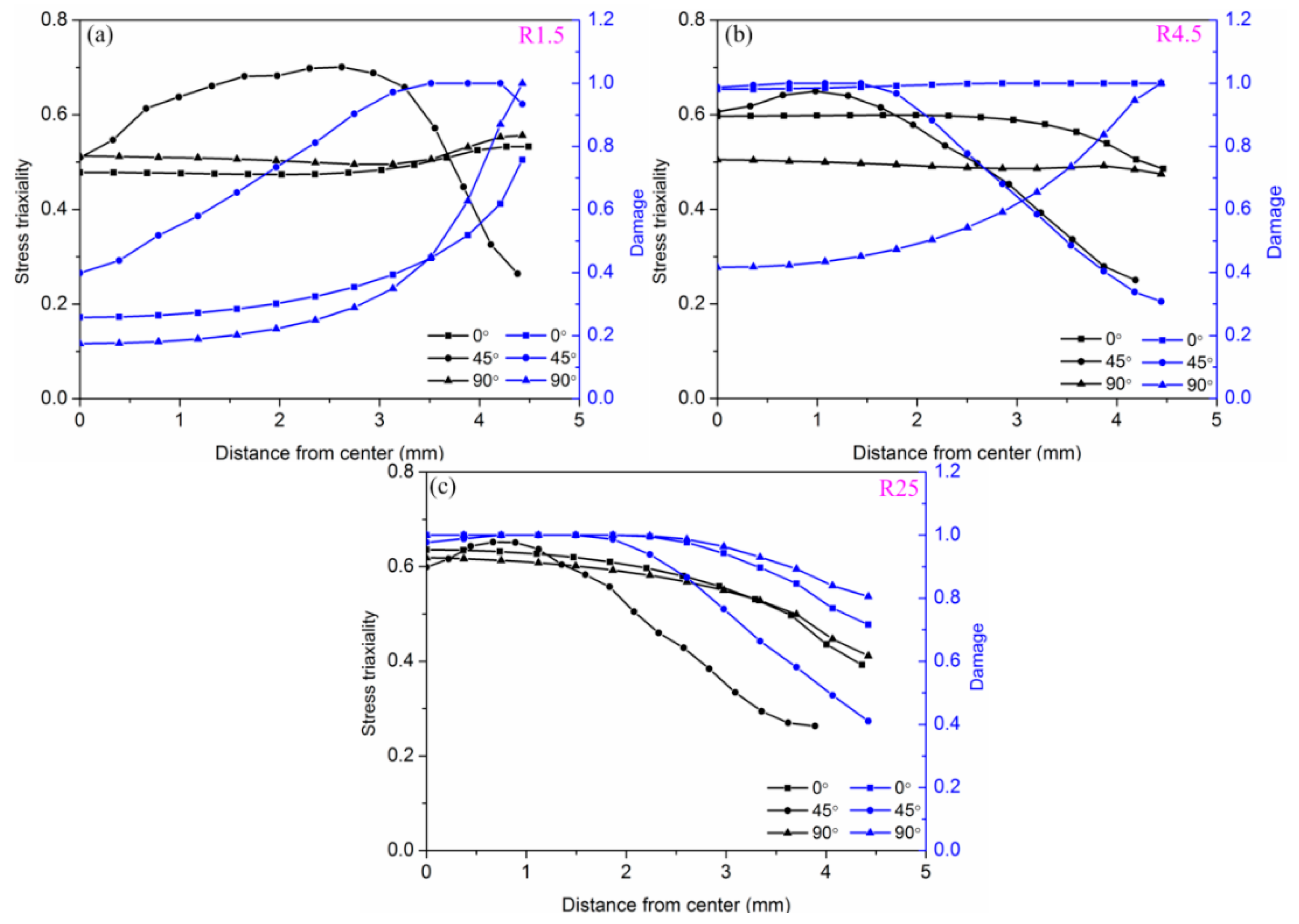
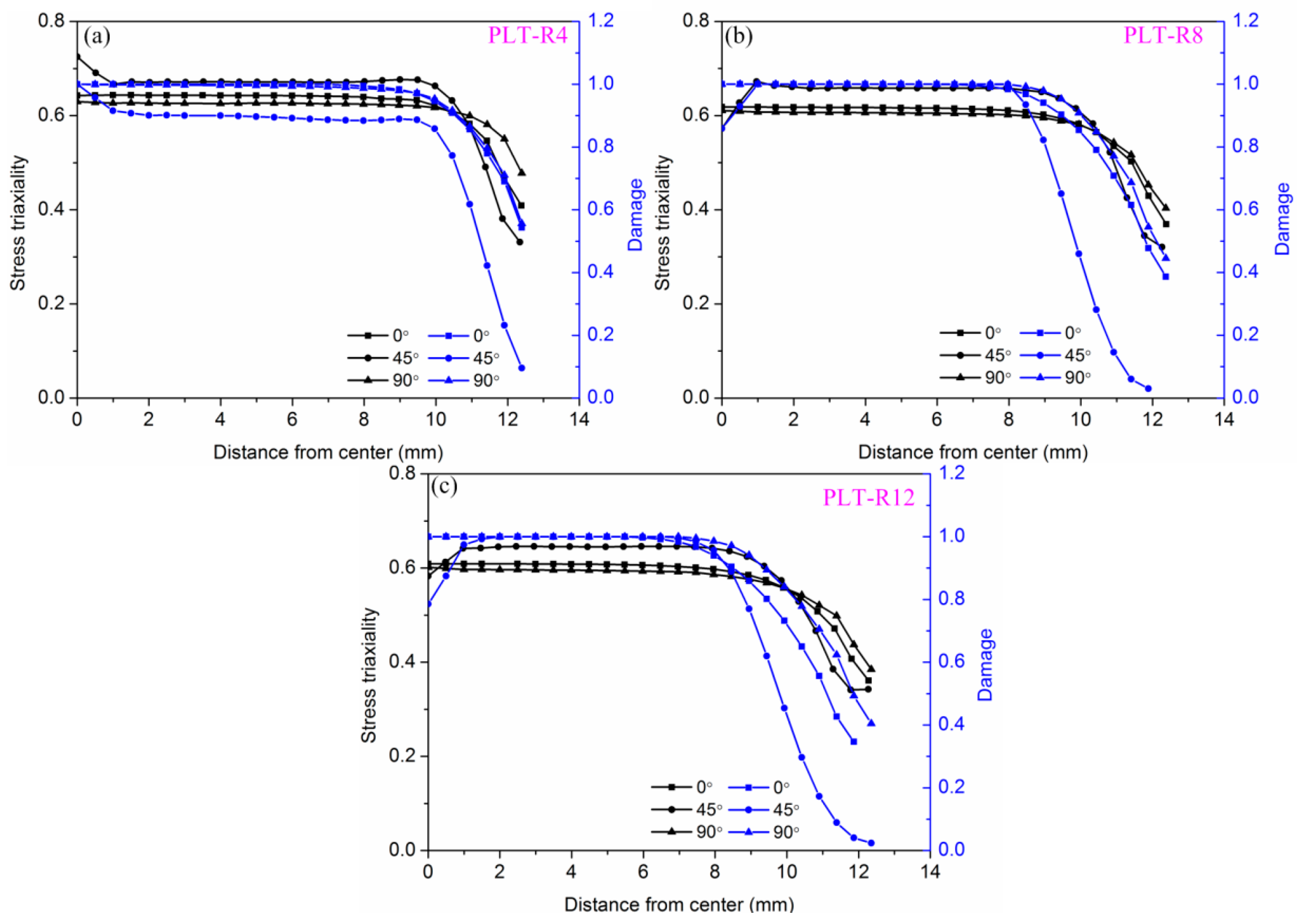


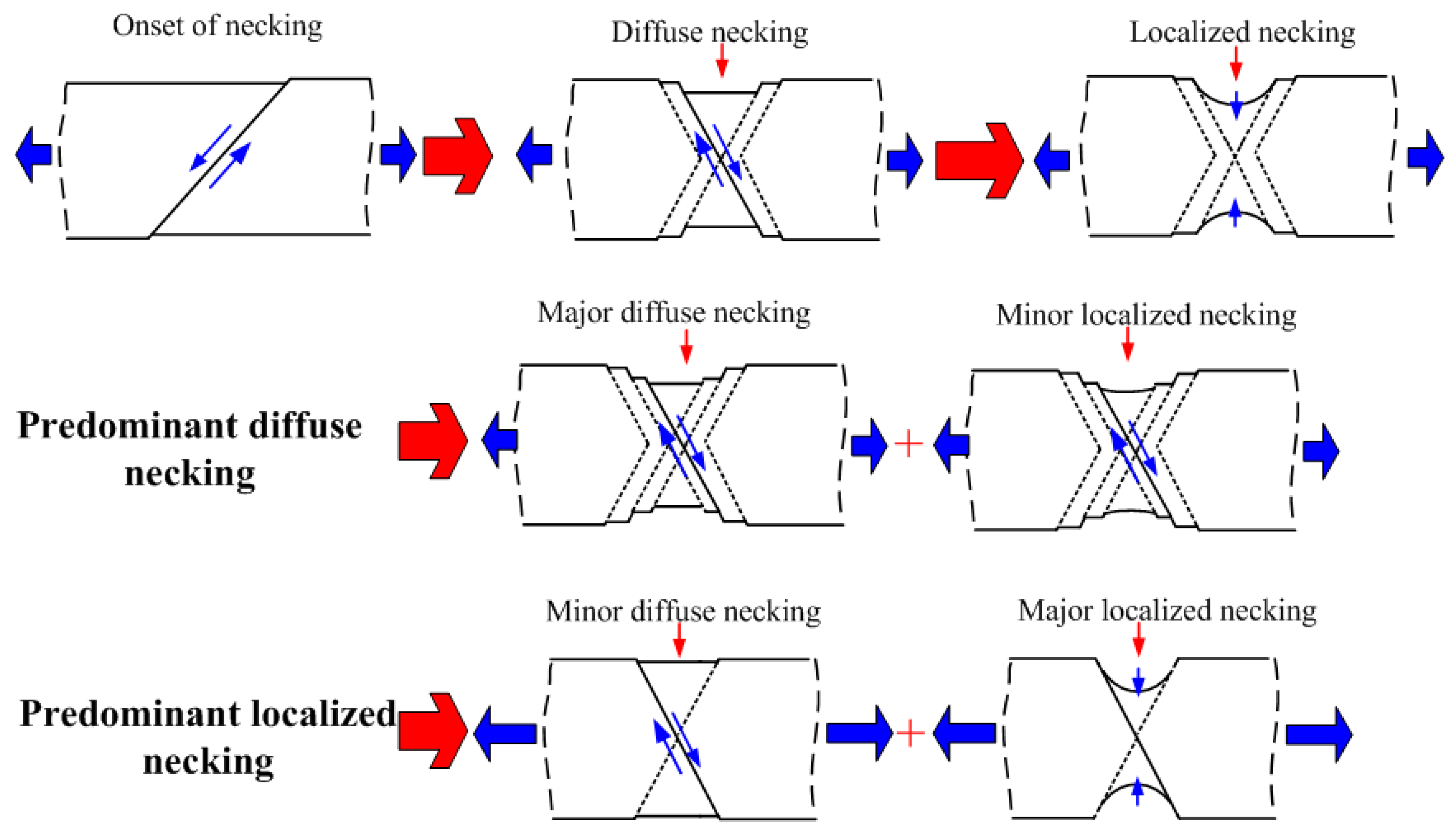

| F | G | H | N | |||||
|---|---|---|---|---|---|---|---|---|
| 0.4143 | 1.2792 | 0.7694 | 0.9355 | −0.6874 | 0.3807 | 0.7071 | 0.2929 | 1.9354 |
| Materials Orientation | P | P0 | ||||
|---|---|---|---|---|---|---|
| 0° | 1.79 | −0.0505 | 0.3154 | 0.5856 | −0.6111 | 0.2584 |
| 45° | 1.39 | −0.0788 | 0.3264 | 0.4084 | −0.6605 | 0.1527 |
| 90° | 2.07 | −0.0723 | 0.2776 | 0.5208 | −0.9823 | 0.2344 |
| K | n | ||||
|---|---|---|---|---|---|
| 827 | 0.16316 | 0.00233 | 600 | 153 | 18.96 |
| Materials Orientation | R1.5 (%) | R4.5 (%) | R25 (%) | PLT-R4 (%) | PLT-R8 (%) | PLT-R12 (%) |
|---|---|---|---|---|---|---|
| 0° | 18.45 | 18.18 | 16.48 | 23.4 | 29.5 | 18.18 |
| 45° | 17.52 | 11.44 | 2.7 | 2.707 | 2.32 | 5.32 |
| 90° | 24.82 | 16.2 | 3.63 | 21.11 | 32.26 | 18.22 |
© 2019 by the authors. Licensee MDPI, Basel, Switzerland. This article is an open access article distributed under the terms and conditions of the Creative Commons Attribution (CC BY) license (http://creativecommons.org/licenses/by/4.0/).
Share and Cite
Zhang, H.; Zhang, H.; Li, F.; Cao, J. A Novel Damage Model to Predict Ductile Fracture Behavior for Anisotropic Sheet Metal. Metals 2019, 9, 595. https://doi.org/10.3390/met9050595
Zhang H, Zhang H, Li F, Cao J. A Novel Damage Model to Predict Ductile Fracture Behavior for Anisotropic Sheet Metal. Metals. 2019; 9(5):595. https://doi.org/10.3390/met9050595
Chicago/Turabian StyleZhang, Hua, Hong Zhang, Fuguo Li, and Jun Cao. 2019. "A Novel Damage Model to Predict Ductile Fracture Behavior for Anisotropic Sheet Metal" Metals 9, no. 5: 595. https://doi.org/10.3390/met9050595
APA StyleZhang, H., Zhang, H., Li, F., & Cao, J. (2019). A Novel Damage Model to Predict Ductile Fracture Behavior for Anisotropic Sheet Metal. Metals, 9(5), 595. https://doi.org/10.3390/met9050595





